Mastering Pork Ribs on the Grill: Techniques and Tips
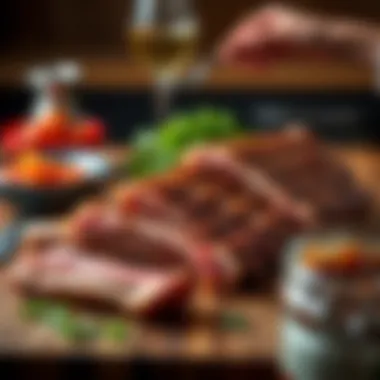
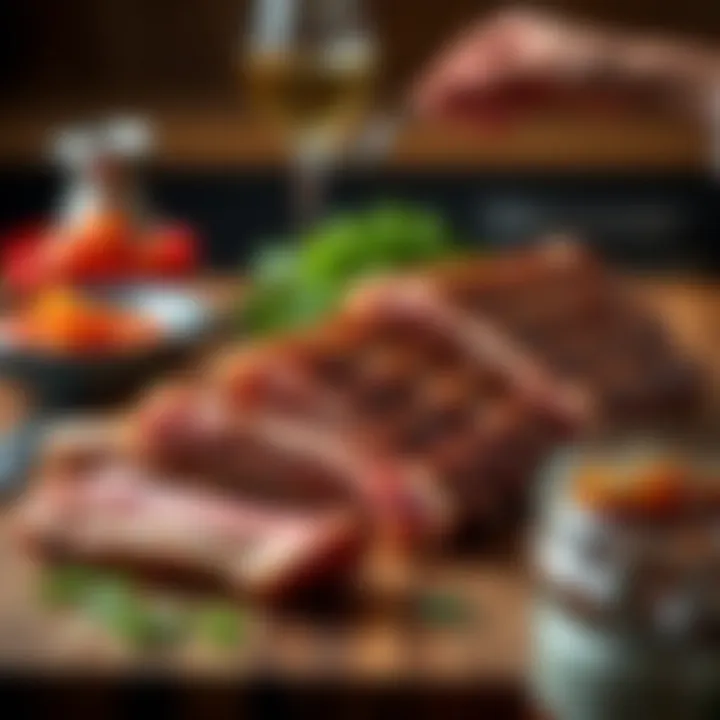
Ingredients Breakdown
When it comes to grilling pork ribs, understanding the components that go into the dish elevates the experience significantly. Selecting quality ingredients sets the stage for remarkable flavor and tenderness. Let’s delve into the essential ingredients and tools required for crafting perfectly grilled ribs.
Primary Ingredients
- Pork Ribs: Choose between baby back ribs or spare ribs, each offering a unique texture and flavor. Baby back ribs are leaner and tenderer, while spare ribs provide a richer taste due to higher fat content.
- Rub: A dry rub is critical to imparting flavor. Common components include brown sugar, paprika, garlic powder, onion powder, and black pepper. Feel free to adjust spice levels based on your preference.
- Sauce: Choose a favorite barbecue sauce for glazing, or consider making a homemade blend for a personal touch. A good sauce should balance sweetness and tang.
Optional Ingredients
- Marinades: Consider a marinade for overnight soaking, which can enhance tenderness. Ingredients like apple cider vinegar or soy sauce are popular options.
- Wood Chips: For that smoky flavor, use wood chips such as hickory or mesquite, adding a layer of complexity to the grilled meat.
Essential Kitchen Tools
- Grill: A charcoal or gas grill works best. Each has its own merits; charcoal lends authenticity while gas offers convenience.
- Meat Thermometer: To guarantee the ribs are cooked to the proper temperature, a reliable meat thermometer is crucial.
- Basting Brush: For applying sauces during cooking, a basting brush is an indispensable tool.
- Tongs: Long-handled tongs will keep you safe and help maneuver the ribs with ease.
Step-by-Step Preparation
Preparation is key to ensuring that your grilled pork ribs are juicy and flavorful.
Prepping the Ingredients
Begin by removing the silver skin from the back of the ribs. This membrane can toughen during cooking, so it’s best to rid of it. After that, apply a generous layer of the rub, thoroughly massaging it into the meat. Let the ribs sit for a while, ideally at least 30 minutes, to absorb the flavors.
Cooking Techniques and Methods
When it comes to grilling, indirect heat is your pal. Preheat the grill and position the ribs away from direct flame. For charcoal grills, create a two-zone fire; for gas, turn on one side only. Keep the temperature around 225°F (107°C) for low and slow cooking. Cook the ribs for about 3-4 hours, basting every now and then, especially in the last hour if using sauce.
Assembly and Presentation Tips
Once the ribs are beautifully caramelized, remove them from the grill. It's important to let them rest for about 10 minutes before slicing. This will allow the juices to redistribute. Slice between the bones for perfect portions. Present them with a sprinkle of fresh herbs or chopped green onions for a pop of color.
Dietary Considerations
In today's diverse culinary landscape, it’s pertinent to recognize dietary requirements.
Gluten-Free Options
Ensure that any rubs or sauces used are gluten-free. Many commercially available barbecue sauces fit the bill, but always check the labels.
Vegetarian and Vegan Substitutes
For those who prefer plant-based options, consider using Jackfruit as a substitute. When cooked and seasoned well, it can mimic the texture of pulled pork quite effectively.
Nutrition Facts & Nutritional Considerations
Pork ribs can be high in fat. A single serving often contains a significant portion of daily caloric needs. Balancing with side dishes such as salads can create a more nutritious meal.
Variations and Customizations
Exploring different flavor profiles can be a captivating aspect of home grilling.
Flavor Enhancements
Consider experimenting with different spices in your rub, such as cumin or cayenne for a kick. You can also add a splash of apple juice to the grilling pan to infuse sweetness.
Alternative Cooking Methods
If grilling isn’t an option, slow cookers or ovens can be used effectively. For ovens, maintain a low temperature and cover with foil for tender results.
Pairing Suggestions (Sides, Drinks, etc.)
Ribs pair beautifully with coleslaw, baked beans, or corn on the cob. For beverages, consider sweet tea or a light beer, balancing the rich flavors of the ribs.
Common Questions and Answerss and Troubleshooting
Navigating the path to perfect ribs may come with its challenges.
Frequently Asked Questions
- How do you know when ribs are done? They should be tender and the meat should pull back from the bone slightly. An internal temperature of about 195°F (91°C) is preferred.
Common Mistakes to Avoid
- Overcooking: Keep an eye on the ribs. Overcooking can lead to dryness. Use a meat thermometer to check doneness.
- Skimping on the Rub: Generously season your ribs. Underseasoning can result in bland flavors.
Solutions to Potential Problems
If your ribs turn out too tough, next time consider cooking them at a lower temperature for longer, ideally utilizing indirect grilling.
Grilling pork ribs is as much an art as it is a science. With careful attention to detail and a willingness to adapt, you'll find that even the most complex techniques can be broken down into simple steps. Mastering rib preparation is not just a culinary skill but a delightful experience that brings friends and family alike around the grill.
Understanding Pork Ribs
When it comes to grilling, pork ribs hold a special place in the hearts of many culinary enthusiasts. Familiarizing oneself with the nuances of pork ribs is essential; it plays a critical role in ensuring the best flavor and texture in your grilled dishes. Understanding the various types, their characteristics, and the particular merits they bring to the grill can significantly influence the experience of both the grill master and the diners alike.
Types of Pork Ribs
Pork ribs can be divided into several distinct categories, each possessing its characteristics and unique appeal. Taking the time to differentiate them not only aids in selection but also enhances the overall cooking experience.
Spare Ribs
Spare ribs are known for their generous portion of meat and a fair amount of fat marbling, which contributes to their rich flavor. Unlike some other cuts, spare ribs are cut from the lower part of the pig, giving them a slightly longer and flatter appearance. This cut is often favored for its robust taste and texture. When cooked properly, spare ribs can turn out succulent and juicy. However, they may require a bit more attention during grilling to prevent them from drying out.
Pros:
- Flavorful and meaty: Spare ribs provide a satisfying experience for those who prefer a flavorful bite.
- Versatile: They can easily absorb marinades and dry rubs, making them adaptable to various cuisines.
Cons:
- More fat: The fat can create flare-ups on the grill, so careful monitoring is necessary.
Baby Back Ribs
Baby back ribs derive their name from their smaller size, as they are cut from the upper portion of the pig, near the spine. Despite their diminutive stature, they are prized for their outstanding tenderness and leaner meat. The flavor is often milder compared to spare ribs, which can appeal to those who prefer a less overpowering taste. They usually tend to cook faster, allowing for quicker meal preparation.
Pros:
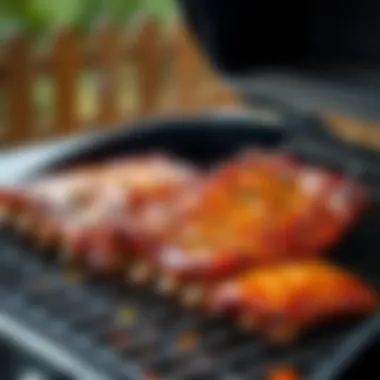
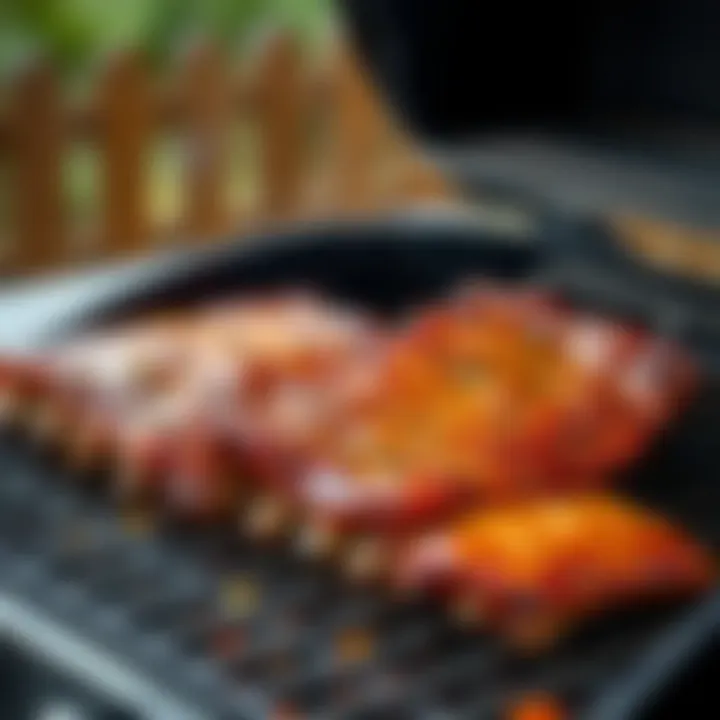
- Tender and juicy: A favorite among many, they offer a delicate bite that melts in your mouth.
- Less fat: They contain less fat than spare ribs, yielding a cleaner taste.
Cons:
- Less meat: They can be more expensive, and their smaller size means you might need more racks to feed a crowd.
St. Louis Style Ribs
St. Louis style ribs are a variation of spare ribs, notably trimmed to produce a neater, rectangular shape. This cut enhances the cooking process, as the uniform shape promotes even cooking. Fans of BBQ often select St. Louis style for its balance of meat and fat, making them incredibly tender when cooked right.
Pros:
- Uniform shape: This cut ensures consistent cooking across the rack.
- Great flavor: The balance between meat and fat enhances the overall taste experience.
Cons:
- More trimming needed: They might require a bit more preparation before grilling compared to baby backs.
Choosing the Right Cut
Selecting the perfect pork ribs goes beyond merely knowing the types. There are underlying factors to consider that affect the taste and overall outcome of the dish.
Factors to Consider
When deciding on a rib cut, several factors come into play: flavor preference, cooking method, and occasion, to name a few. Consider your audience; will they appreciate a fattier rib, or do they lean toward healthier options? Understanding the preferences of those you’re cooking for allows you to make informed decisions, resulting in well-received dishes.
- Flavor profiles: Some people love rich, bold flavors, while others may go for something subtler.
- Cooking methods: Certain cuts can handle higher heat better than others.
Quality Indicators
Choosing quality ribs is essential. Look for fresh cuts with a good balance of meat and fat. Color is also an indicator; fresh pork should appear to be pinkish-red. If the ribs have an unusual odor or discoloration, that’s usually a red flag. Selecting quality cuts directly impacts the success of your grilling endeavors.
- Color: Bright, pink-red indicates fresh meat.
- Marbling: Fat distribution can enhance flavor and tenderness.
Buying From Butchers vs. Grocery Stores
This decision can greatly affect the quality of your ribs. Butchers often provide fresher, higher-quality products and personalized service, offering insight into the best cuts available each day. On the other hand, grocery stores may offer convenience and sometimes lower prices, but quality might not be consistent. Weighing the pros and cons can help steer you toward the best choice for your next grilling session.
- Butchers: Often supply higher-quality meats and can suggest specific cuts.
- Grocery stores: Generally more convenient but may lack variety and freshness.
Choosing the right cut is not only about meat preference but also about optimizing the cooking process and ensuring flavor that pleases everyone.
Preparation Techniques
Preparation is the backbone that sets the stage for a successful grilling experience, especially when it comes to pork ribs. Proper preparation ensures that your ribs are not only clean and trimmed but also primed to soak up those flavors deeply. Moreover, it’s about developing techniques that enhance texture and taste while also ensuring even cooking. Whether you're a novice or a seasoned griller, paying attention to how you prepare your pork ribs can make all the difference.
Trimming and Cleaning Ribs
Removing the Membrane
Removing the membrane from the ribs may seem like a tedious task, but it's a crucial step that can drastically improve the final taste and texture. The membrane is a thin, tough layer of connective tissue found on the bone side of the ribs. It can prevent marinades and rubs from penetrating the meat, leading to a flavor that can be quite one-dimensional. By eliminating this barrier, the ribs can be more receptive to your seasonings.
One of the key characteristics of removing this membrane is that it allows for better smoke penetration, which is essential for creating that irresistible smoky flavor. However, it can be a tricky process. You can use a butter knife to gently pry up one corner of the membrane and then pull it off with your fingers or a paper towel for better grip. Just be gentle; you don’t want to leave shards behind that could mess with your grilling experience.
Trimming Excess Fat
When it comes to trimming excess fat from pork ribs, moderation is key. While a little fat can add flavor and moisture during cooking, too much of it can lead to greasy ribs and less-than-pleasing mouthfeel. Trimming fat properly helps to maintain a balance where the ribs remain juicy without being overloaded.
Trimming also results in a more attractive presentation. Visually appealing food is always more enjoyable to eat. When trimming, focus on big fatty areas that aren’t necessarily flavorful. You still want to keep some of that marbling for moisture, but cutting away big hunks of pure fat is a smart move. Just keep in mind that you should avoid cutting too close to the meat as you might lose some juicy goodness.
Preparing for Seasoning
Before throwing down the seasoning, it’s essential to give your ribs a good wipe-down and pat them dry. This preparation step ensures that your seasonings cling better, creating a nice flavorful crust as they cook. One characteristic that stands out during this step is that it allows for a cleaner base, which can enhance the overall taste of the ribs.
Now, depending on the style of ribs you’re aiming to cook, you can choose to let them sit for a bit after seasoning. This resting period allows spices to meld into the meat, raising them a notch in flavor intensity. The unique feature of preparing your ribs for seasoning is that it emphasizes the individual flavors, letting the complexities shine through rather than settling for a layer of simply salty or sweet. While it might seem like one more step, this practice pays off as the results will be evident in the final bite.
Marinating and Brining
Benefits of Marinating
Marinating pork ribs not only enhances flavor but also helps in tenderizing the meat. This is particularly important for tougher cuts, as the acid in marinades, such as vinegar or citrus juice, helps break down fibrous tissues. Through marination, you’re essentially imparting flavors that can penetrate deeper than just surface seasoning.
One noteworthy aspect of marinating ribs is the versatility it offers. Different marinades can completely transform the profile of the ribs, whether you gravitate towards tangy, spicy, or sweet flavors. However, timing is crucial; marinating for too long can lead to a mushy texture, so it's best to keep to a time limit based on the strength of the marinade.
Basic Brine Recipes
Brining is another method that works wonders for enhancing the juiciness of pork ribs. A basic brine typically includes water, salt, and sugar, though adding spices like garlic, herbs, or even apple cider can elevate your brine to another level. The process uses osmosis to draw moisture into the meat, ensuring the final product is flavorful and succulent.
Creating a basic brine is an easy way for beginners to get started. Since brining doesn’t require much specialized knowledge, it makes a great starting point for anyone seeking to ensure juicy ribs. While the ratios can be quite flexible, aiming for a solution of around 1/4 cup of salt and sugar to water—adjustable based on your taste—is a good rule of thumb.
Timing for Marinating
Timing plays a crucial role in achieving the perfect pork ribs. A good rule of thumb is to marinate for at least two hours but no more than twelve hours. This ensures that the meat absorbs enough flavor without becoming overly soft. If you're using a highly acidic marinade, aim for shorter times as the acid works quickly.
What stands out about timing for marinating is the crucial balance between flavor enhancement and maintaining texture. The key is to experiment; every type of rib and marinade might yield slightly different results, so keeping notes on your timing will help you perfect your technique over time.
Taking the time to properly prepare pork ribs can elevate your grilling game from simple to extraordinary. Treat every step as an opportunity to enhance flavor and ensure tenderness.
Seasoning and Flavoring
Seasoning and flavoring are vital elements when it comes to grilling pork ribs. These techniques not only enhance taste but also bring out the natural smokiness that ribs are capable of. Achieving the right balance in flavorings can elevate a humble rib into a memorable dish. Not many dishes resonate with that smoky, savory hit like well-prepared ribs—an art form crafted through the specific selection of spices and sauces.
Dry Rubs vs. Sauces
Crafting a Dry Rub
A dry rub is a blend of aromatic spices that you rub directly onto the meat before cooking. What’s critical about dry rubs is their ability to infuse flavor without adding moisture. This technique allows the ribs to develop a beautiful crust while keeping the meat tender. Crafting a robust dry rub typically involves a mix of salt, sugar, paprika, garlic powder, and other spices. The key characteristic that makes dry rubs appealing is simplicity; they allow the actual flavor of the pork to shine through without overwhelming it.
One notable feature of dry rubs is how they can vary dramatically by region. For instance, a rub from Texas may lean heavily on chili powder and cumin, while a North Carolina version might focus more on a mix of brown sugar and mustard powder. The advantages here are clear: easy to apply, non-messy, and they often provide an irresistible crust that even the pickiest eaters can appreciate. However, find the sweet spot; too much salt can overpower, while too little can leave the ribs bland.
Popular BBQ Sauce Recipes
BBQ sauces bring a different angle to flavoring and can transform ribs from basic to extraordinary. A tangy BBQ sauce can cut through the richness of the meat and leave an excellent layer of juiciness. Key characteristics of BBQ sauces often include a sweet and tangy profile, a combination of sweeteners like brown sugar or molasses, along with vinegar for that necessary acidity.
Many classic BBQ sauces have their origins; Kansas City BBQ sauce is known for being thick and sweet, whereas vinegar-based sauces found in the Carolinas are runnier and dominated by tanginess. The unique feature of BBQ sauce is its versatility—it can either complement or stand out against the meat flavors, depending on the application. This flexibility also comes with its own set of trade-offs—while some enjoy the rich flavors sauces contribute, others may feel they mask the essence of the rib itself.
Combining Techniques
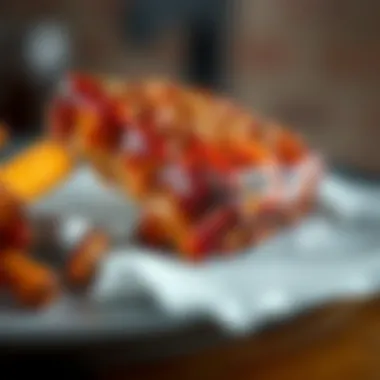
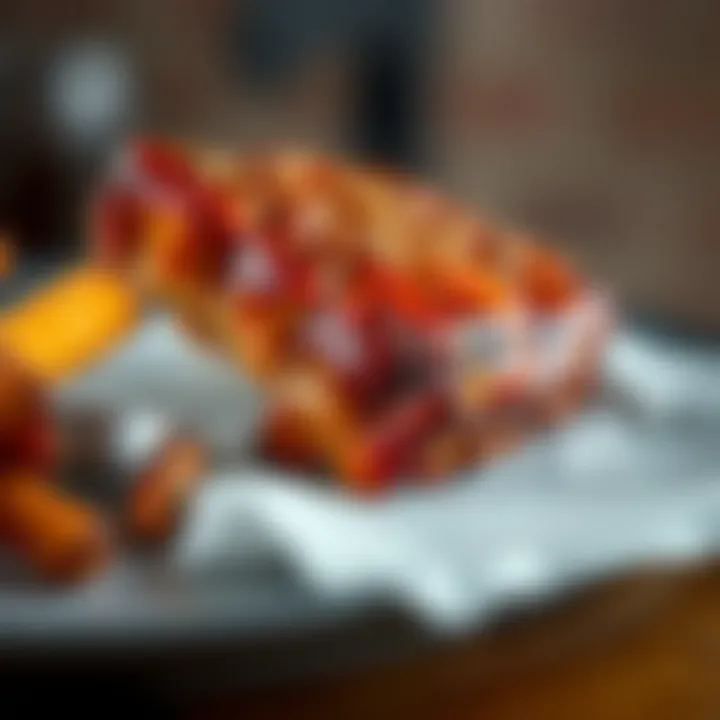
Combining dry rubs and BBQ sauces could lead to your winning rib recipe. It’s not uncommon for cooks to apply a dry rub, allowing it to set in, and follow up with a glaze of sauce toward the end of cooking. This method capitalizes on the advantages of both techniques; the dry rub forms a crust while the sauce adds shine and depth of flavor as it caramelizes under heat. Key characteristics of this hybrid approach include enhanced texture, as the crunchy exterior provides a satisfying contrast to the juicy interior.
However, blending these two methods can be a double-edged sword. Too much sauce may overpower the hard-won flavor from the rub, while inadequate application could lead to a lackluster end product. Tread carefully; finding the balance between these flavoring techniques could truly deliver the ideal ribs.
Regional Flavor Profiles
American BBQ Styles
American BBQ styles reflect a rich tapestry of regional foods, techniques, and influences. Each area prides itself on its unique takes, from the smoky flavors of Texas and the vinegar tang of the Carolinas to the sweet profiles of Kansas City. The key characteristic of American BBQ is its regionalism. Depending where you are, each style has its signature rubs or sauces that speak to local traditions and ingredients.
The advantage of knowing these styles is that you can adapt seasoning and cooking methods to create highly localized versions or even experiments. This could be amazing if you're hosting a BBQ competition or just looking to impress friends with something different at your grill.
Caribbean Influence
Caribbean flavors add another dimension to pork ribs. These marinades often include tropical ingredients like jerk spices, pineapple, and citrus, giving the ribs a sweet and spiced finish. The key characteristic of this style is the boldness. Jerk seasoning, with its unique blend of scotch bonnet peppers, allspice, and thyme, creates a flavor explosion that few can resist.
As a fun approach, you may choose to marinate overnight for deeper flavor penetration. However, be cautious; strong marinades can overpower delicate pork flavors if left too long. Using the Caribbean influence can transform an ordinary BBQ into an exotic feast, but it takes a keen hand to ensure harmony in flavors.
Asian Marinades
Asian marinades often focus on balance—sweet, salty, and spicy elements blend to create an engaging flavor palette. Ingredients like soy sauce, ginger, garlic, and sesame can yield ribs with an unmistakably tender and juicy bite. The key characteristic here is the umami richness; nearly every bite is imbued with a depth that lifts the ribs far beyond simple grilling.
These marinades also often require shorter marinating times compared to others, which can be a great advantage for those short on time. However, if over-marinated, there's a risk of the meat becoming mushy. The beauty of Asian marinades is in their ability to surprise, giving a familiar ingredient a new life.
Grilling Setup
Setting up the grill is a pivotal aspect of achieving delicious pork ribs. This stage is where precision and preparation collide, determining how well the ribs cook and taste. A proper setup not only enhances the flavor but also ensures even cooking and prevents common pitfalls that can lead to frustration. From selecting the right grill type to understanding heat application techniques, this section covers essential elements that can make or break your grilling experience.
Choosing the Right Grill
Charcoal vs. Gas
When it comes to grilling, one of the first decisions is whether to use charcoal or gas. Charcoal grills are beloved for their ability to impart an unmistakable smoky flavor that many enthusiasts crave. The key characteristic of a charcoal grill lies in its straightforward fuel source: lump wood or briquettes. This fuel type brings a distinct, rich flavor, which is particularly beneficial for cooking pork ribs, as it enhances the natural sweetness of the meat.
On the downside, charcoal grills require a bit of patience and practice to master temperature control.
Gas grills, on the other hand, are known for their convenience, boasting quick ignition and versatile heat control. This can appeal to those who prioritize ease of use. They reach the desired temperature faster, offer a more consistent heat, and can be adjusted on-the-fly. However, some might argue that they miss out on the deep flavors that charcoal grills offer.
Pellet Grills
Pellet grills present a unique fusion of convenience and flavor. They utilize wood pellets as fuel and incorporate a digital temperature control system, allowing for precise heat management. The standout feature of pellet grills is their capacity for smoking, roasting, and grilling all in one. This versatility makes them an increasingly popular choice among grillers who desire robust flavors without the guesswork of charcoal.
However, they can fall short in terms of sheer heat intensity compared to a charcoal grill. It's a good fit for those who enjoy subtle smoke notes in their food without having to tend to the fire continuously.
Electric Grills
For those who live in urban settings or have space constraints, electric grills can provide a suitable alternative. They heat quickly and require minimal setup, making them great for indoor use or smaller outdoor spaces. The advantage of electric grills is their precise temperature control, which is easy to manage, particularly for novice grillers.
While they may not offer the same depth of flavor as charcoal or wood options, many models allow for wood chip smoking, lending some degree of smokiness to the ribs. Still, serious grillers may find the flavor a bit lacking when compared to traditional methods.
Setting Up the Grill
Direct vs. Indirect Heat
Understanding the difference between direct and indirect heat is crucial for successful grilling. Direct heat exposes the ribs to the flame directly, perfect for achieving a good sear. This method is quicker, allowing for caramelization of the rib's sugars, which can enhance flavor.
Indirect heat, however, involves placing the ribs away from the flame. This slow-cooking method is ideal for larger cuts, ensuring they cook evenly without burning. Each method has its place, but mastering when to use each one can significantly elevate your grilling game.
Temperature Control
Temperature control is an essential skill in the grilling process. Maintaining a steady temperature is critical for cooking pork ribs to the right level of tenderness. A grill thermometer will be your best friend here. It ensures that you have the right conditions for smoking ribs, typically around 225°F to 250°F. If you stop paying attention to this detail, you might end up with dry ribs instead of the tender, juicy ones you aim for.
Using a Water Pan
The addition of a water pan during grilling is another technique worth mastering. It helps to maintain moisture in the cooking environment, creating a more forgiving space for your ribs. This not only adds a layer of protection against drying out but can also enhance the cooking process by regulating temperature fluctuations. It’s as simple as placing a pan filled with water beneath the ribs, contributing to steamy conditions that are particularly favorable for slow cooking.
"Grilling isn’t just a task; it’s an art form best mastered with careful consideration of setup and technique."
By combining the right grill type with proper setup and techniques, you’ll be set up for successful grilling sessions that yield flavorful, fall-off-the-bone pork ribs. Preparing each element with thoughtfulness ensures that the end result is both satisfying and delicious.
Cooking Techniques
When it comes to grilling pork ribs, the cooking techniques used can truly make or break your culinary endeavor. Getting to grips with the right cooking techniques ensures that your ribs are not only tasty but also pleasingly tender, making each bite an experience worth savoring. Mastering various methods means you won’t just be grilling; you’ll be crafting a work of art on the grill.
Understanding the core elements of cooking ribs, such as timing, temperature, and technique, goes hand in hand with the end result you desire. These elements influence flavor and texture, ensuring that the ribs are cooked evenly while maintaining moisture.
Cooking Times and Temperatures
Understanding Internal Temperature
The internal temperature of pork ribs plays a crucial role in achieving that coveted tenderness. Cooking to the right temperature helps break down tough connective tissues, leading to a more enjoyable eating experience. Ideally, the ribs should reach an internal temperature of about 190 to 203 degrees Fahrenheit. This range ensures that the collagen has melted, transforming your ribs into a juicy, flavorful dish that melts in your mouth.
A key characteristic of monitoring internal temperature is that it’s not just about avoiding undercooked meat; it’s a fantastic guide for reaching that perfect doneness. Knowing when to pull the ribs from the grill while they still have a bit of residual heat can enhance the juiciness, giving you ribs that don’t have that dry aftermath. While using a meat thermometer is beneficial, developing an intuition about that perfect point can be even more rewarding.
Timing Guidelines for Different Cuts
Different cuts of pork ribs require varying cooking times due to their size and fat content. For instance, baby back ribs typically cook faster compared to spare ribs. It’s essential to understand these timing variations to avoid either overcooking or undercooking. Baby back ribs may take around 4 to 6 hours at a low temperature, while spare ribs might take closer to 6 to 8 hours.
This guideline can help in planning your grill session effectively and avoids the stress of discovering you're still cooking an hour before your guests arrive. An important component here is recognizing that timing can depend on your grill’s heat and the thickness of the ribs. Therefore, having patience pays off in dividends.
Resting Period
After the ribs are pulled off the grill, allowing them to rest for a period is key to consolidating the flavors and juices within the meat. During this resting period, which should last about 10 to 15 minutes, the juices redistribute throughout the meat. This step is often forgotten, yet it can significantly affect the overall texture and moisture content of the ribs.
Incorporating a resting period is beneficial because it helps prevent the juices from spilling out upon cutting, which maintains the flavor and delivers a delightful bite. One unique characteristic here is that while you’re resting the ribs, you can utilize that time to prepare any sauces or sides, making good use of every moment.
Flipping and Basting Ribs
How Often to Flip
Flipping the ribs during cooking not only helps achieve a uniform color but also prevents burning. However, you don’t want to be flipping them around every five minutes like a hotcake; timing is key. Generally, flipping every 30 to 40 minutes allows for even cooking while still allowing the smoke and flavors to set in.
The advantage here is that you create a nice crust on the outside that holds the moisture in, without losing the delicious smoky flavor. However, over-flipping can lead to drying out the meat, so find a balance that works for you.
Basting Techniques
Basting is an art form all its own. Using a basting sauce can enhance flavor by adding glaze and moisture during the cooking process. The key here is to time your baste correctly—doing so towards the end of the cooking process can enhance the flavor without washing away the initial rubs.
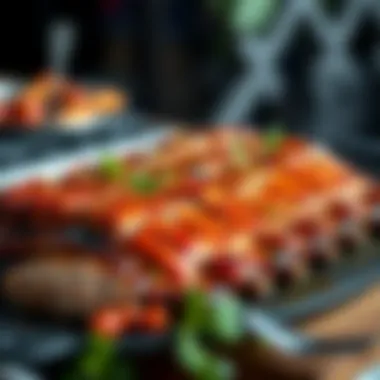

A good baste can range from a simple BBQ sauce to a more complex concoction of herbs and spices. The unique aspect of basting is that it can also meld into a glaze as it cooks, creating that irresistible sticky texture that draws everyone in. Basting frequently can lead to a build-up of moisture, which can be enjoyable but sometimes prohibits that desired crispy exterior. Thus, finding the right balance in timing and technique is essential.
Signs of Doneness
Recognizing when your ribs are done is both an art and a science. You should look for a few signs: the meat should have pulled back slightly from the bones, and the edges should start to caramelize. Visual cues, combined with checking the internal temperature, help you gauge doneness effectively.
The unique aspect of identifying doneness is that it combines those essential elements of sight and touch, allowing for a more intuitive cooking experience. Although relying solely on these signs can be risky, they often provide foolproof insights when combined with thorough practices.
In summary, mastering cooking techniques—from understanding internal temperature to timing and recognizing doneness—will elevate your grilling skills dramatically. For those prepared to invest the time, the reward is a batch of succulent, mouthwatering pork ribs.
Finishing Touches
Finishing touches are what truly elevate grilled pork ribs from a simple meal into a culinary experience. These final steps can greatly influence presentation and flavor, leaving a lasting impression on anyone lucky enough to partake. Let's break down the importance of these finishing acts, focusing particularly on creating a glaze and the subsequent presentation and serving techniques.
Creating a Glaze
Glaze Ingredients
A well-crafted glaze is the cherry on top—quite literally. The ingredients of a glaze can vary widely. Common choices include soy sauce, honey, brown sugar, apple cider vinegar, and various spices. An effective glaze typically balances sweetness with a touch of tanginess. This duality ensures that the savory richness of the pork is highlighted rather than overshadowed.
Some ingredients, like apple cider vinegar, have a unique feature—they enhance the tenderness of the meat while adding flavor. The complexity of sweet and sour makes it a popular choice for those grilling pork ribs. However, one must be cautious with the amount of sugar used; excess can lead to burning if applied too early.
Timing for Application
Timing is essential when applying a glaze. Many grill enthusiasts recommend adding the glaze during the last 30 minutes of cooking. This approach ensures that the glaze caramelizes beautifully without caramelizing too much, which can mask the deep flavors of the ribs.
Applying it too early can lead to a charred, bitter taste and defeat the purpose of that perfect balance we aim for. This careful timing is a crucial part of the overall grilling process, helping to transform the ribs into melt-in-your-mouth delights.
Enhancing Texture and Flavor
Adding a glaze not only boosts flavor but also enhances texture. A good glaze gives ribs a shiny, appealing coat that beckons to diners. The exterior becomes slightly sticky, creating a delightful contrast to the tender meat beneath.
The ideal glaze adds gloss without overwhelming the rib's natural attributes. This is another reason why a glaze is such a beneficial technique; it serves both aesthetic and gustatory purposes while ensuring the dish doesn’t lose its identity amidst added flavors.
Presentation and Serving
Cutting Technique
A proper cutting technique is essential for maximizing both presentation and flavor. Ribs should be sliced between the bones to ensure a clean cut. This method not only makes for a more appealing presentation but also makes it easier for guests to eat.
Inconsistently cut ribs may result in jagged edges that can detract from the clean aesthetic we strive for. Simultaneously, cutting incorrectly can lead to a loss of those all-important juices that keep the ribs moist and flavorful.
Serving Suggestions
When it comes to serving pork ribs, presentation plays a major role. Arranging the ribs in a fan shape or stacked neatly on a platter instantly elevates the dining experience. Consider accompanying the dish with flavorful sides—coleslaw, baked beans, or cornbread—each contributing their own textures and taste while highlighting the flavors of the pork ribs.
Using fresh herbs as garnish can also add a pop of color and freshness, enhancing the visual impact of the dish. Remember, we eat with our eyes first!
Accentuating with Sides
The sides you choose to pair with your pork ribs should complement the main attraction rather than compete for attention. Classic accompaniments like macaroni and cheese or grilled vegetables can add a delightful diversity to the plate.
Mixing textures is key; for instance, pairing crispy sides with the tender ribs provides an enjoyable mouthfeel. Serving elements that carry light seasoning, such as a simple salad, can help balance the richness of the ribs, offering a well-rounded meal.
Overall, completing the grilling process with thoughtful finishing touches informs not only the flavor but also the presentation of the dish. Each component matters, from the glaze to the side dishes, ultimately transforming your pork ribs into a memorable culinary delight.
Troubleshooting Common Issues
Grilling can bring out the flavors in pork ribs like nothing else, but it doesn’t always go as planned. The risk of running into common issues is as real as the smooth sizzle of the meat on the grill. Understanding these potential pitfalls and how to tackle them is critical to anyone wanting to elevate their grilling game. This section delves into two significant concerns—overcooked ribs and insufficient flavor—shedding light on techniques for preventing and resolving each issue.
Overcooked Ribs
Overcooked ribs can go from juicy goodness to dry disappointment in the blink of an eye. It’s paramount to identify when ribs have crossed that line, so let’s break it down.
Identifying Signs of Overcooking
The most glaring sign of overcooked ribs is the texture. When you bite into a rib, it should yield tender meat that gently pulls away from the bone rather than a sawdust-like chew. Another telltale sign is the color: if the meat is a pale, unappealing gray, it’s a strong indication that it has been cooked beyond its prime. In this article, recognizing overcooked ribs helps grillers avoid a major setback, assuring the desired tender and juicy experience.
Rescue Techniques
If you discover your ribs have crossed the line into overcooked territory, there are a few tricks up your sleeve. One popular approach is to slather them in a rich sauce and wrap them in foil, tossing them back on the grill at a low temperature for a while. The steam created in the foiled wrap can help to reintroduce some moisture. This technique is a beneficial choice because, while it won't restore the ribs to their original glory, it can salvage the meal and add layers to flavor.
Preventive Measures
To avoid the dreaded overcooked ribs, keep an eye on the internal temperature with a reliable meat thermometer. Aim for around 190-205°F for perfectly tender results. Timing also plays a key role; adhere closely to the cooking guidelines for the specific cut of ribs you’re using. Stepping away from the grill might be tempting, but regular checks and adjustments will help you stay on top of things. These methods are key to enjoying the succulent life that good grilling can offer.
Insufficient Flavor
Flavor is the heart and soul of grilling—that’s what transforms a basic meal into an unforgettable experience. If your ribs lack that exciting punch of flavor, it’s time to dive deep into some remedies.
Analyzing Flavor Profiles
Start by assessing what’s missing in the flavor profile of your ribs. Was the seasoning too light? Did you go a little too heavy on the meat while neglecting the accoutrements? A successful analysis involves breaking down the layers of taste you’re aiming for. This step is vital in aiding you to create a balanced and robust experience that can stand up to any standards. Evaluating flavor profiles allows grillers to pinpoint adjustments needed in seasoning and technique, fostering that perfect blend.
Enhancing with Seasoning
If there's a lack of flavor, step up your seasoning game. It can be as simple as adding another layer of rub or sauce during the cooking process. Using dry rubs in the beginning is great, but don’t hesitate to add a little more sauce before the ribs are finished cooking. This not only boosts flavor but also adds that sticky glaze everyone loves. This method makes seasoning adjustments a more beneficial alternative, allowing flavors to meld during cooking rather than just sitting on the surface.
Balancing Acidity and Sweetness
Achieving that perfect balance between acidity and sweetness can elevate your ribs from mediocre to mouth-watering. If your ribs are tasting flat, consider adding a splash of vinegar or citrus as part of your marinade or at serving. Sweet elements like honey or brown sugar also push the flavors higher and counteract any harsh notes. Striking this balance is an essential skill to cultivate; mastering it means you have the upper hand in crafting truly memorable ribs.
"The difference between a good meal and a great one often lies in the subtleties of flavor balance."
Armed with these techniques and tips, overcoming common grilling hurdles will become less of a chore and more of a confident stride towards creating unforgettable pork ribs. In this guide, troubleshooting is not merely about fixing mistakes, but also about learning, experimenting, and ultimately deepening your understanding of the art of grilling.
Ending
In this article, the conclusion serves as a crucial wrap-up for anyone wanting to fully grasp the art of grilling pork ribs. It encapsulates not just the techniques discussed, but also the nuances that elevate the amateur grilling experience to new heights. Understanding the importance of why and how each step plays a role offers the reader a sense of empowerment. The conclusion brings clarity to the entire process—from selecting the ideal ribs to the final presentation on the plate.
Reflecting on the Process
Key Takeaways
Among the key takeaways from our discussion, the most significant aspect is the careful balance of seasoning and cooking methods that results in tender, flavorful ribs. This balance isn't just a hit-or-miss situation; it is a refined craft that anyone can develop with practice. The fundamental characteristic of this takeaway is that it encourages meticulousness and attention to detail. It’s not merely about throwing meat on the grill; instead, it’s about knowing how every ingredient and technique can impact the final product. A unique feature of this approach is how it emphasizes customization according to personal taste, allowing grillers to create unique flavor profiles that resonate with their preferences. This leads to an exquisite dining experience that makes enduring the trial-and-error process worthwhile.
Encouragement for Continued Learning
Encouraging readers for ongoing education in grilling not only aids their mastery of the craft but also fosters a community of enthusiastic cooks. The benefit of this approach is that it opens up avenues for exploration and experimentation in flavors, techniques, and cultural influences in grilling. With grilling being an evolving art form, the unique feature here is the constant adaptation to new styles and methods from around the globe. By embracing this continued learning, grillers develop a more rounded skillset, which can lead to surprising culinary innovations. This encouragement stands as a reminder that every cook has room to grow, regardless of their starting point.
Exploring Further Recipes
Exploring further recipes is another essential part of the journey into grilling mastery. The unique characteristic of adding an assortment of recipes is how expounding one’s culinary repertoire keeps the grilling experience fresh and exciting. Instead of sticking rigidly to old favorites, branching out presents a chance to discover hidden gems that could become new staples in the grilling lineup. One important aspect to note is that recipes from various cultures can introduce unexpected techniques and flavor combinations, enhancing the grilling journey. The advantage is a broadened scope of traditional grilling paradigms, allowing cooks to continually enrich their culinary artistry as they delve into new and exciting flavors.







